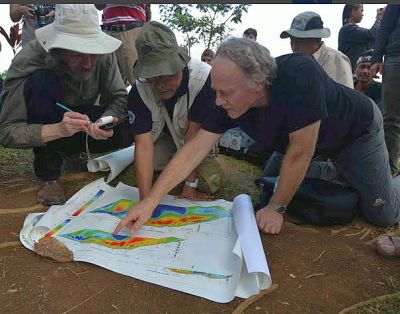Facebook (Thanks, Richard)

On site at Gunung Padang, “the Mountain of Light”, West Java, Indonesia. Photo shows Danny Hilman PhD (centre) senior geologist at Indonesia’s Geotechnology Centre, Robert Schoch PhD (left of picture) geology professor at Boston University (renowned for his geological redating of the Great Sphinx of Giza) and myself, Graham Hancock, at the right of the picture.
Dr Hilman is showing us some of the remote sensing results his team have obtained at Gunung Padang over the past two years of research. They have conducted extensive surveys with electrical resistivity, ground penetrating radar and seismic tomography and have analysed drill cores from selected areas across this mysterious and complex site.
A brief synopsis is that there are large man-made structures of columnar basalt down to 15 metres beneath the surface with carbon found in the soils between the blocks giving dates that extend back as far as 26,000 years, but with intermediate dates of 17,000 years ago, 12,500 years ago and 11,600 years ago rising to as recently 2,500 years ago at the presently exposed surface. There is no doubt that the columnar basalt elements at all depths reflect human construction since they are laid in horizontal and in some cases sloping layers, whereas columnar basalt in its natural state is found only in the vertical formations.
